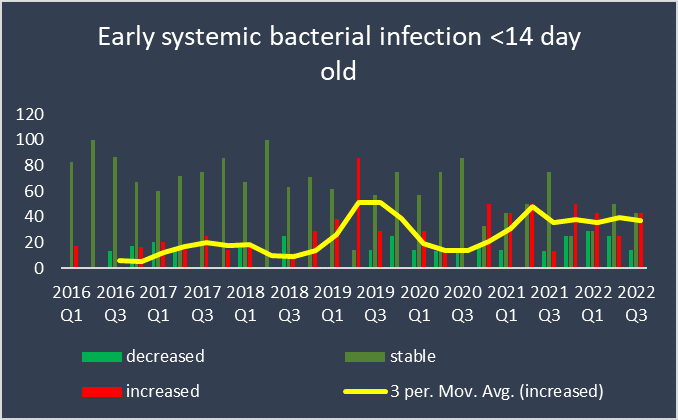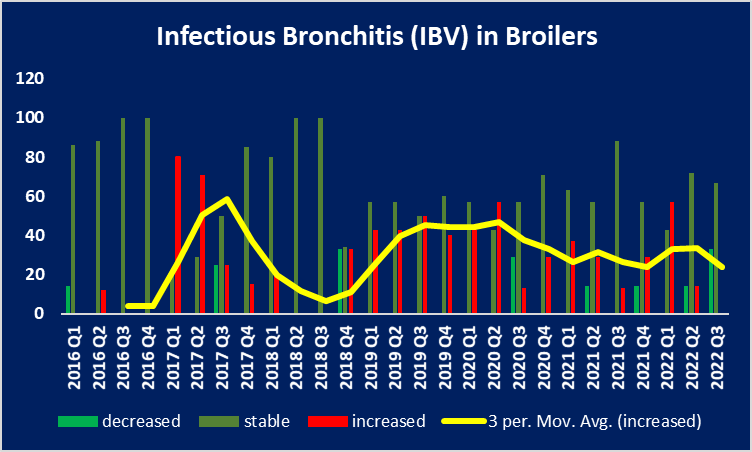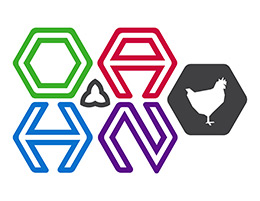Ontario Animal Health Network (OAHN)
Poultry Expert Network
Quarterly Veterinarian Report
Fowl Adenovirus Microneutralization Summary (September 2021 to August 2022)
Emily Martin and Tanya Rossi, Animal Health Laboratory, University of Guelph
Below is a summary of the Fowl Adenovirus microneutralization test for chicken broiler-breeders between September 1, 2021 and August 31, 2022. This test is run on serum pooled in the laboratory from not more than 15 individual birds. The data is summarized by positive sample (one or more birds in the sample are positive) and by positive submission (one or more samples in a submission are positive). Percent positive submissions are also calculated and the result are shown as both tables and graphs. FAdV08b and FAdV11 are presented separately.
FAdV08b:












Poultry Veterinarian Survey Highlights – Q3 2022
Broilers
Early systemic bacterial infection (<14 d old)
AHL: The number of cases were decreased from last quarter. The majority of cases had pure culture of E. coli identified while the remaining cases had E. coli isolated in combination with E. cecorum and one case also had C. perfringens identified.
Practitioners: An equal number of practitioners indicated stable or increased cases this quarter. Escherichia coli in combination with Enterococcus cecorum were identified by practitioners.

Other causes of early mortality (>14 d old)
AHL: Numbers of cases were similar to previous quarters. One case of mycotic pneumonia identified.
Practitioners: Generally stable to increased cases this quarter.
Late systemic bacterial infection (>14 d old)
AHL: The numbers of cases were decreased from previous quarters. Almost an equal number of cases had either E. coli in pure culture or in combination with E. cecorum. In 2 cases these bacteria were identified with C. perfringens. In 1 case E. coli was isolated with P. aeruginosa.
Practitioners: Stable this quarter with E. coli and Enterococcus cecorum the main bacteria identified. Practitioners reported that 0-20% of E. coli isolates have been resistant to Trimethoprim sulfa (TMS).
Lameness – viral
AHL: This is the 3rd quarter that numbers have been stable but reduced from previous quarters. There are only 2 reovirus strains identified this quarter: ON_classic_10-077184 and ON_classic_10- 076656.
Practitioners: Cases were reported as stable to slightly decreased.
Lameness – bacterial
AHL: Cases were stable compared to last quarter. Primarily diagnosed on histology with 1 case of E. coli tenosynovitis.
Practitioners: Reported as stable to slightly increased for this quarter and cases were attributed to E. cecorum.
Lameness – developmental
AHL: Cases of tibial dyschondroplasia were increased from previous quarters but the same as Q3 2021.
Practitioners: Stable cases this quarter.
Lameness – nutritional
AHL: No cases of nutritional related lameness were diagnosed this quarter.
Practitioners: Reported as stable to decreased . Rickets (calcium or vitamin D deficiency) were noted as the causes for nutritional lameness.
Ascites
AHL: No cases of ascites were diagnosed this quarter.
Practitioners: Reported as stable.
Coccidiosis and necrotic enteritis
AHL: Cases were reported as stable compared to previous quarters.
Practitioners: Cases were reported as stable. Necrotic enteritis was diagnosed by respondents in 1 week old chickens.
Inclusion body hepatitis (IBH)
AHL: Histologic cases were decreased but viral isolations are stable. The predominant species identified was ‘E’. When sequenced the primary strain identified is FAdV08b (i.e. FAdV08b_AHL_16-049095_ON and FAdV08b_AHL_18-057921_ON). Two cases identified FAdV11_USA_1047.
Practitioners: Cases were reported as stable to slightly increased compared with last quarter
Infectious bursal disease
AHL: Stable cases compared to last quarter with increased variability of strains that are primarily vaccine related (i.e. UK Faragher 52-70 vaccine, USA Del-A-SVS510 vaccine, USA W2512 – Blen Vaccine, USA Del-E field strain, Ont 05-SA08-03-25355 field strain, USA PA105-2014 field strain, and BC 15-062782 field strain).
Practitioners: Reported as generally stable with an equal number of practitioners indicating decreased or increased cases this quarter.
Infectious bronchitis (IBV)
AHL: Cases were decreased from last quarter as well as the variety of strains (i.e. IBV_Conn-AHL 21-008165 vaccine, IBV_DMV_ON_21-017385, and IBV_DMV_ON_15-077145).
Practitioners: Reported as decreased to stable.

Spiking mortality
Practitioners: Reported as stable this quarter.
Salmonella
Practitioners: Salmonella isolations were reported as stable to decrease his quarter.
Histomoniasis (blackhead)
Practitioners: Reported as stable.
Runting and Stunting Syndrome (RSS)
AHL: Confirmed cases of RSS (diagnosed on histology) were decreased this quarter.
Practitioners: RSS caused by astrovirus were reported as stable by most veterinarians except one that reported increased cases this quarter.
Other diagnostic findings
AHL: Other diagnoses made at the AHL included urate nephrosis/visceral urates, cellulitis, osteomyelitis, and amyloidosis.
Practitioners: Reported increased cases of Aspergillosis in flocks that are younger than usual.
Condemnation issues
Practitioners: Issues were reported as stable by veterinarians this quarter. Cellulitis was the most common cause of condemnations.
Slaughter provincial plants: Processing volume average 1.7M per month. The top 3 condemnation conditions were reported as dead on arrival (DOA), cellulitis and airsacculitis.
Slaughter federal plants: Processing volume average 17.7 M per month. Sub-cutaneous, hepatitis and ascites were reported as the main conditions for condemnation.
Broiler-Breeders
Fowl cholera
AHL: Occasionally isolated from lameness cases from vaccinated flocks.
Practitioners: Reported stable and associated with lameness related to vaccination.
Early bacterial infection (<14 d old)
AHL: The number of cases were slightly decreased from previous quarters. Cases had either E. coli in pure culture or in combination with E. cecorum. In 1 case these bacteria were identified with G. anatis. In 1 case E. coli was isolated with P. aeruginosa.
Practitioners: Reported a shift from stable to slightly increased . The main bacteria isolated was E. coli. One respondent reported that different lines in males with increased early mortality due to E.coli septicemia.
Other causes of early mortality (<14 d old)
AHL: None diagnosed this quarter.
Practitioners: Reported as stable this quarter.
Lameness – bacterial
AHL: Stable compared to previous quarters. Primarily pure cultures of S. aureus, E. coli, E. cecorum or P. multocida (vaccinated flocks). Also, cases of combined S. aureus and E. coli.
Practitioners: Stable to increased. Staphylococcus aureus, E.coli and occasionally Pasteurella have been the most common bacterial cause of lameness.
Lameness – viral, developmental and nutritional
AHL: No cases diagnosed this quarter.
Practitioners: All reported as stable.
In-lay bacterial septicemia
AHL: Increased slightly from previous quarters. There are a few pure bacterial cultures of E. coli or S. aureus. It is more common to identify combined infections of 2-3 different bacteria.
Combinations often include E. coli with E. cecorum or E. coli with S. aureus. These 2 combinations can have a 3rd bacteria isolated such as G. anatis or C. perfringens.
Practitioners: Septicemia was reported as stable. Practitioners listed E. coli, Enterococcus, Clostridium perfringens, and Gallibacterium anatis as commonly isolated bacteria. One responder commented that mixed bacterial infections are resolved after few weeks of treatment.
IBV- decreased production/ abnormal eggs
AHL: Three cases of cystic oviducts identified this quarter.
Practitioners: Stable to slightly decreased this quarter.
IBV – sudden spike in mortality
AHL: The virology lab identified a variety of strains that included vaccine strains (i.e. IBV_Mass-MA5 vaccine, IBV_Mass-H120 vaccine, CU82792 AHL 21-043746, IBV_DMV_ON_21-017385, IBV_DMV_ON_15-077145, and IBV_CA_1734_04_ON_12-025379).
Practitioners: Stable. One practitioner reported two cases in adjacent barns with severe mortality and production effects (egg production low to mid 70%) due to a strain 83.1% similar to CU82792.
Disease related hatchability issues and mycoplasmosis
Practitioners: Reported as stable to slightly decreased for this quarter. One case of Mycoplasma synoviae was mentioned by one respondent.
Necrotic enteritis
Practitioners: The number of necrotic enteritis cases reported were stable this quarter.
Coccidiosis
AHL: Decreased cases. Identified both E. necatrix and E. tenella cases.
Practitioners: Stable to slightly increased cases. Practitioners mentioned E. necatrix and E. tenella as the main coccidia parasites present in the flocks.
Fowl pox and ILT
Practitioners: Remained stable for this quarter.
Salmonellosis (clinical)/Salmonella isolation
Practitioners: Stable this quarter. Practitioners reported a variety of Salmonella isolates including S. Livingstone and S. Mbandaka
Aggression and cannibalism
Practitioners: Cases were reported as generally stable with an equal number of practitioners indicating decreased or increased cases this quarter.
Multi-drug resistant E. coli (resistant to >3 drugs)
Practitioners: Reported as stable.
Histomoniasis (blackhead)
AHL: Stable case numbers with 2 cases identified this quarter.
Practitioners: Stable cases. Practitioner reported one severe case of histomoniasis with 5% lost in a week in a flock at 29 weeks of age. Treatment of this condition was not successful.
Other
AHL: A case of swollen wattles had pure culture of S. aureus identified. One case of gangrenous dermatitis had a mixed culture of E. coli, S. aureus, and C. perfringens. One case of orchitis had E. coli isolated. Two cases of granulomatous hepatitis were identified histologically and 1 case had P. multocida isolated.
Practitioners: None reported.
Respondents stated that autogenous vaccines used in the flocks are for Reovirus, IBH and Salmonella.
Layers
Overall, good and stable health status for this quarter.
Osteoporosis
Practitioners: Stable.
Bacterial peritonitis/salpingitis
Practitioners: Stable to slightly decreased and E.coli isolated.
Early systemic bacterial infection (<14 old)
Practitioners: Stable. E.coli and Staphylococcus isolated.
Other causes of early mortality (>14 d old)
AHL: One case of septicemia identified on histology.
Practitioners: Stable and there were no other causes of early mortality identified by practitioners.
Focal duodenal necrosis
AHL: One case identified on histopathology.
Practitioners: Stable.
IBV- production drop/abnormal eggs and respiratory issues
AHL: Cases are low but stable in the last 3 quarters. Case numbers substantially decreased from 1 year ago (Q3 2021). Strains were primarily vaccine related (i.e. IBV_Conn-AHL 21-008165 vaccine, IBV_Mass-MA5 vaccine). Only 1 case of IBV_DMV_ON_15-077145 was identified.
Practitioners: Stable to slightly decreased.
Salmonellosis (clinical) / Salmonella isolation
Practitioners: Both reported as stable.
Salmonella submissions – 22 isolates. Fewer submissions compared with Q1 2022.
The most common isolates in chickens were Heidelberg, Typhimurium, and Enteritidis.
Ontario Hatchery and Supply Flock Policy (OHSFP) – isolates of Salmonella in chicken with the following subtypes: Enteritidis, S. I:8, 20: -: z6, Livingstone variant 14+, Kiambu and Kentucky.
ILT
AHL: No cases identified this quarter.
Practitioners: Stable.
Mycoplasma species
Practitioners: Stable.
Coccidiosis and necrotic enteritis
AHL: One case of coccidiosis diagnosed.
Practitioners: Stable.
Aggression, cannibalism and hysteria
Practitioners: All reported as stable.
Multi-drug resistant E. coli (resistant to >3 drugs)
Practitioners: Stable.
Histomoniasis (blackhead)
AHL: No cases diagnosed this quarter.
Practitioners: Stable.
Other
AHL: One case of necrotizing dermatitis was diagnosed.
Practitioners: None.
Turkeys
Overall stable health with early and late systemic bacterial infections more commonly seen in the field.
Fowl cholera
Practitioners: Stable.
Erysipelas
AHL: Three cases of E. rhusiopathiae identified on bacterial culture.
Practitioners: Stable to slightly increased
Early systemic bacterial infection (<14 day old)
AHL: One case of S. Typhimurium diagnosed.
Practitioners: Stable to decreased cases. The most common bacteria isolated were E.coli and Pseudomonas.
Other causes of early mortality (<14 d old)
AHL: No additional causes of early mortality diagnosed.
Practitioners: Stable to decreased. Piling and dehydration were the main causes of other mortalities.
Late systemic bacterial infection (>14 d old)
AHL: Three cases diagnosed on histopathology.
Practitioners: Stable. E.coli was the main bacteria identified to be responsible for late systemic bacterial infection.
ORT
Practitioners: Stable to slightly decreased.
Mycotic respiratory disease
AHL: One case of mycotic pneumonia diagnosed.
Practitioners: Stable to slightly decreased. One practitioner reported one case of mycotic pneumonia.
Other respiratory disease
Practitioners: Stable.
Necrotic enteritis and enteritis
Practitioners: Generally, stable to slightly increased but mostly encountered in raised without antibiotics (RWA) flocks.
Mycoplasma (species)
Practitioners: Stable.
Coccidiosis
Practitioners: Stable to slightly increased. Eimeria meleagrimitis was the main subtype of coccidia identified by the practitioners.
Salmonellosis (clinical)/Salmonella isolation
Practitioners: Stable. One respondent related that Salmonella was cultured from a case of septicemia.
Ontario Hatchery and Supply Flock Policy (OHSFP) Salmonella isolated in turkey with the following subtypes: Infantis, Holcomb, Livingstone variant 14+, Uganda and Hadar.
Reovirus tenosynovitis
AHL: One case with histologic lesions and positive on PCR.
Practitioners: Stable to slightly decreased.
Round heart
Practitioners: Stable to decreased cases.
Aggression and cannibalism
Practitioners: Stable to slightly increased.
Multi-drug resistant E. coli (resistant to >3 drugs)
Practitioners: Stable to slightly decreased.
Histomoniasis (blackhead)
AHL: Two cases diagnosed on histopathology.
Practitioners: Reported stable to slightly increased and associated with high mortality. One practitioner reported that a treatment trial with paromomycin was administered in the feed on flocks that experienced Histomoniasis with no improvements; the approach needs to be explored further to see if water soluble medication works better when treating this condition.
Other
AHL: Additional diagnoses included 2 cases of heterophilic tenosynovitis and 1 case of dilated cardiomyopathy.
Practitioners: None.
Provincial slaughter plants: Processing volume average of 14,000/month. The top 3 conditions of condemnation were abscesses, cellulitis and airsacculitis.
Federal slaughter plants: Processing volume average of 653,000 per month. The top 3 conditions of condemnation were subcutaneous, respiratory and emaciation.
Rural/Backyard/Non-Quota Flocks
Less respiratory disease over the summer. Sinusitis with increased swelling had Streptococcus suis isolated. Reproductive diseases included E.coli salpingitis, and age related tumors. Increased fecal testing revealed a variety of parasites. Starting to see neurologic signs from chicks hatched in the spring (likely Marek’s disease). Lameness cases can present unilaterally with splayed toes, no mobility and swollen hock but unable to diagnose the cause due to lack of testing.
Marek’s disease
Neurologic forms continue to be diagnosed and the number of cases increased this quarter.
The most encountered clinical cases reported by practitioners in urban poultry were diarrhea and endoparasites, bumblefoot, mites, lice, respiratory disease (CRD, sinusitis) reproductive disease (egg yolk peritonitis, neoplasia), lameness, wounds, and nutritional issues.
The infectious and parasitic agents identified by the practitioners in urban flocks were: Marek’s disease, Mycoplasma gallisepticum and M. synoviae, S. suis, E.coli, coccidia, roundworms, Capillaria, and Heterakis.
Practitioners reported respiratory issues, lice and mites as well as S. suis with hobby flocks.
Responders were finding coccidia infection in non-quota commercial flocks for personal/local consumption of eggs or meat.
AHL:
Chickens: Cases at AHL had a variety of diagnoses for parasites (coccidia, Ascaridia), and tumours (Marek’s, adenocarcinoma, leiomyoma, lipoma). Respiratory infections included mycotic pneumonia and bacterial pneumonia (E. coli and S. aureus). Other diagnoses included necrotic enteritis, salpingitis, and cellulitis/panniculitis. There was one case of ILT typed as a Niagara-like field strain (CAGG cluster).
Duck: Diagnoses included a suspicious case of Leukocytozoonosis, P. multocida septicemia, and airsacculitis/pneumonia.
Goose: One case of airsacculitis/pneumonia.
Turkey: One case of omphalitis and yolk sacculitis.
Poultry research from Ontario and beyond
- Reduction in Antimicrobial Use and Resistance to Salmonella, Campylobacter, and Escherichia coli in Broiler Chickens, Canada, 2013–2019 – PMC (nih.gov)
- Foods | Free Full-Text | Comparison of Antimicrobial Resistance and Pan-Genome of Clinical and Non-Clinical Enterococcus cecorum from Poultry Using Whole-Genome Sequencing | HTML (mdpi.com)
- Paromomycin Sulfate Treatment in Histomoniasis Outbreaks in Three Commercial Turkey Flocks in the Fraser Valley of British Columbia, Canada – PubMed (nih.gov)
- Efficacy of Commercial Infectious Bronchitis Vaccines against Canadian Delmarva (DMV/1639) Infectious Bronchitis Virus Infection in Layers – PMC (nih.gov)
- Pathogenicity of the Canadian Delmarva (DMV/1639) Infectious Bronchitis Virus (IBV) on Female Reproductive Tract of Chickens – PMC (nih.gov)
- Vaccines | Free Full-Text | Coccidiosis: Recent Progress in Host Immunity and Alternatives to Antibiotic Strategies | HTML (mdpi.com)
- Biosecurity Assessment and Seroprevalence of Respiratory Diseases in Backyard Poultry Flocks Located Close to and Far from Commercial Premises | Request PDF (researchgate.net)
Events and News
Poultry Industry Council events: https://www.poultryindustrycouncil.ca/events
Poultry Health Research Network information, events, and lectures can be accessed on the PHRN website: https://phrn.net/ or on the PHRN YouTube channel: https://www.youtube.com/user/PoultryHRN
Thank You!
We thank the following poultry veterinarians who completed the veterinary survey:
Dr. Elizabeth Black, Dr. Joanne Rafuse, Dr. Shahbaz Haq, Dr. Elana Huong, Dr. Anastasia Novy, Dr. Mike Petrik, Dr. Erin Preiss, Dr. Joanne Rafuse, Dr. Fernando Salgado-Bierman, Dr. Kathleen Sary, Dr. Ben Schlegel, Dr. Brenna Tuer, Dr. Lloyd Weber, Dr. Alex Weisz, and Dr. Jessalyn Walkey.


